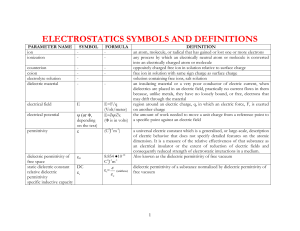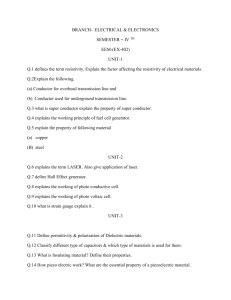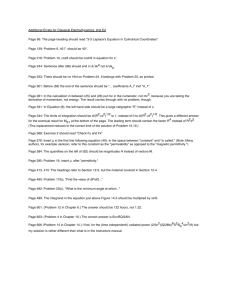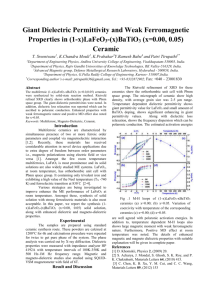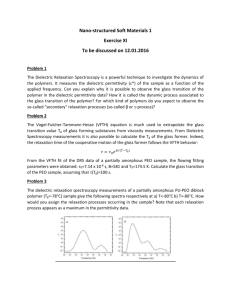Effects of ZrO additions on the dielectric properties of CaCu Ti O
advertisement
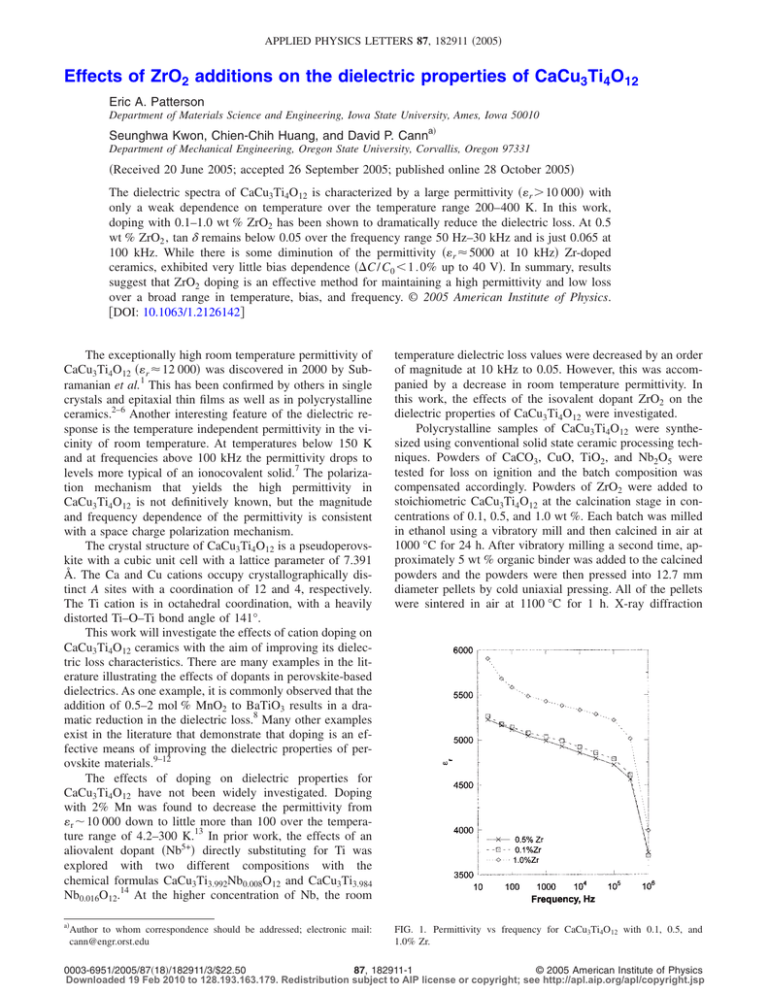
APPLIED PHYSICS LETTERS 87, 182911 共2005兲 Effects of ZrO2 additions on the dielectric properties of CaCu3Ti4O12 Eric A. Patterson Department of Materials Science and Engineering, Iowa State University, Ames, Iowa 50010 Seunghwa Kwon, Chien-Chih Huang, and David P. Canna兲 Department of Mechanical Engineering, Oregon State University, Corvallis, Oregon 97331 共Received 20 June 2005; accepted 26 September 2005; published online 28 October 2005兲 The dielectric spectra of CaCu3Ti4O12 is characterized by a large permittivity 共r ⬎ 10 000兲 with only a weak dependence on temperature over the temperature range 200–400 K. In this work, doping with 0.1–1.0 wt % ZrO2 has been shown to dramatically reduce the dielectric loss. At 0.5 wt % ZrO2 , tan ␦ remains below 0.05 over the frequency range 50 Hz–30 kHz and is just 0.065 at 100 kHz. While there is some diminution of the permittivity 共r ⬇ 5000 at 10 kHz兲 Zr-doped ceramics, exhibited very little bias dependence 共⌬C / C0 ⬍ 1 . 0% up to 40 V兲. In summary, results suggest that ZrO2 doping is an effective method for maintaining a high permittivity and low loss over a broad range in temperature, bias, and frequency. © 2005 American Institute of Physics. 关DOI: 10.1063/1.2126142兴 The exceptionally high room temperature permittivity of CaCu3Ti4O12 共r ⬇ 12 000兲 was discovered in 2000 by Subramanian et al.1 This has been confirmed by others in single crystals and epitaxial thin films as well as in polycrystalline ceramics.2–6 Another interesting feature of the dielectric response is the temperature independent permittivity in the vicinity of room temperature. At temperatures below 150 K and at frequencies above 100 kHz the permittivity drops to levels more typical of an ionocovalent solid.7 The polarization mechanism that yields the high permittivity in CaCu3Ti4O12 is not definitively known, but the magnitude and frequency dependence of the permittivity is consistent with a space charge polarization mechanism. The crystal structure of CaCu3Ti4O12 is a pseudoperovskite with a cubic unit cell with a lattice parameter of 7.391 Å. The Ca and Cu cations occupy crystallographically distinct A sites with a coordination of 12 and 4, respectively. The Ti cation is in octahedral coordination, with a heavily distorted Ti–O–Ti bond angle of 141°. This work will investigate the effects of cation doping on CaCu3Ti4O12 ceramics with the aim of improving its dielectric loss characteristics. There are many examples in the literature illustrating the effects of dopants in perovskite-based dielectrics. As one example, it is commonly observed that the addition of 0.5–2 mol % MnO2 to BaTiO3 results in a dramatic reduction in the dielectric loss.8 Many other examples exist in the literature that demonstrate that doping is an effective means of improving the dielectric properties of perovskite materials.9–12 The effects of doping on dielectric properties for CaCu3Ti4O12 have not been widely investigated. Doping with 2% Mn was found to decrease the permittivity from r ⬃ 10 000 down to little more than 100 over the temperature range of 4.2–300 K.13 In prior work, the effects of an aliovalent dopant 共Nb5+兲 directly substituting for Ti was explored with two different compositions with the chemical formulas CaCu3Ti3.992Nb0.008O12 and CaCu3Ti3.984 Nb0.016O12.14 At the higher concentration of Nb, the room temperature dielectric loss values were decreased by an order of magnitude at 10 kHz to 0.05. However, this was accompanied by a decrease in room temperature permittivity. In this work, the effects of the isovalent dopant ZrO2 on the dielectric properties of CaCu3Ti4O12 were investigated. Polycrystalline samples of CaCu3Ti4O12 were synthesized using conventional solid state ceramic processing techniques. Powders of CaCO3, CuO, TiO2, and Nb2O5 were tested for loss on ignition and the batch composition was compensated accordingly. Powders of ZrO2 were added to stoichiometric CaCu3Ti4O12 at the calcination stage in concentrations of 0.1, 0.5, and 1.0 wt %. Each batch was milled in ethanol using a vibratory mill and then calcined in air at 1000 °C for 24 h. After vibratory milling a second time, approximately 5 wt % organic binder was added to the calcined powders and the powders were then pressed into 12.7 mm diameter pellets by cold uniaxial pressing. All of the pellets were sintered in air at 1100 °C for 1 h. X-ray diffraction a兲 FIG. 1. Permittivity vs frequency for CaCu3Ti4O12 with 0.1, 0.5, and 1.0% Zr. Author to whom correspondence should be addressed; electronic mail: cann@engr.orst.edu 0003-6951/2005/87共18兲/182911/3/$22.50 87, 182911-1 © 2005 American Institute of Physics Downloaded 19 Feb 2010 to 128.193.163.179. Redistribution subject to AIP license or copyright; see http://apl.aip.org/apl/copyright.jsp 182911-2 Appl. Phys. Lett. 87, 182911 共2005兲 Patterson et al. TABLE I. Dielectric Properties of ZrO2-doped CaCu3Ti4O12 ceramics. Permittivity Loss tangent Frequency 共kHz兲 Undoped 0.1% Zr 0.5% Zr 1.0% Zr Undoped 0.1% Zr 0.5% Zr 1.0% Zr 0.1 1 10 100 10 900 9550 8660 8150 5140 5030 4920 4790 5120 4990 4860 4720 5590 5430 5330 5220 0.16 0.084 0.060 0.060 0.031 0.016 0.022 0.065 0.025 0.018 0.023 0.063 0.065 0.019 0.018 0.065 共XRD兲 was utilized to monitor phase evolution and changes in lattice parameter. The density of the pellets was determined using the Archimedes method. The samples were sputtered with gold electrodes and the dielectric properties were measured with an HP-4284A LCR meter utilizing an environmental chamber for the temperature measurements. Impedance spectra were obtained on ceramic specimens utilizing an HP 4194A impedance analyzer. Finally, microstructural analysis was performed on thermally etched cross sections of the sintered ceramics. The room temperature dielectric properties of Zr-doped CaCu3Ti4O12 are shown in Table I. In Fig. 1, the permittivity versus frequency is plotted for CaCu3Ti4O12 with 0.1, 0.5, and 1.0 wt % ZrO2 added. The permittivity of the samples was reduced by a factor of 2 共r ⬃ 4900–5300兲 compared to undoped CaCu3Ti4O12 共r ⬃ 10 000兲. In Fig. 2, the loss tangent is plotted against frequency for the three different doping levels of ZrO2. It is shown that the lowest value of dielectric loss obtained was 0.0158 for 0.1 wt % ZrO2 at 1 kHz. However, the 0.5% ZrO2-doped composition exhibited dielectric losses below 0.05 over a wide frequency range from 50 Hz to 30 kHz. In Fig. 3, the data for the capacitance as a function of voltage for 0.5 wt % ZrO2-doped CaCu3Ti4O12 is shown. The bias dependence was negligible with less than 0.8% change in capacitance for each of the three measurement frequencies. In SrTiO3, a prototypical barrier layer capacitor material, the effects of barrier lowering causes the large per- mittivity value to exhibit a strong bias dependence. From the data in Fig. 3, it can be inferred that the potential drop across each barrier was insignificantly small. More testing at high voltages is necessary to determine whether these properties extend to high electric fields. The temperature dependence of the permittivity and loss tangent for 0.5 wt % ZrO2-doped CaCu3Ti4O12 is plotted in Fig. 4. Above the dielectric relaxation at T ⬃ 150 K, the permittivity was nearly temperature independent up to 400 K. Over the temperature range of −30–85° C the change in permittivity is less than ±3%. While the ZrO2 doping effectively reduced the dielectric loss over a wide range in temperature and frequency, it also lowered the room temperature permittivity. The doping also significantly lowered the rise in the loss tangent at higher temperatures, for both 10 and 100 kHz. This is often indicative of an enhanced resistivity. The XRD data confirmed a modest decrease in lattice parameter with the addition of ZrO2 up to a concentration of 0.5 wt % ZrO2 共with a ⬃0.2% decrease in a0兲. Higher concentrations of ZrO2 did not result in any noticeable shift in lattice parameter, suggesting that the added ZrO2 is most likely present in the microstructure either in the grain boundaries or as a second phase. While no second phase was observed in the XRD data, this is not surprising given the typical detection limits of the technique. Another important point is that the grain size remained at a constant value of approximately 5 m independent of the ZrO2 concentration. Thus the change in the dielectric properties of CaCu3Ti4O12 is apparently not correlated with any significant change in the FIG. 2. Dielectric loss of CaCu3Ti4O12 for 0.1, 0.5, and 1.0% Zr doping FIG. 3. Measurement of the capacitance as a function of applied V for levels. CaCu3Ti4O12 with 0.5% Zr added. Downloaded 19 Feb 2010 to 128.193.163.179. Redistribution subject to AIP license or copyright; see http://apl.aip.org/apl/copyright.jsp 182911-3 Appl. Phys. Lett. 87, 182911 共2005兲 Patterson et al. samples compared to the undoped samples. This finding is consistent with an enhanced grain boundary resistivity due to the presence of ZrO2 at the grain boundaries. While the space charge polarization mechanism inhibits application of CaCu3Ti4O12 for high frequency applications, the material exhibits excellent dielectric properties below 100 kHz. With 0.5 wt % ZrO2 added, CaCu3Ti4O12 exhibits a permittivity in excess of 4900 and a dielectric loss below 0.05 over the frequency range 50 Hz–30 kHz. Given that these dielectric properties are largely independent of temperature and bias, this material is a promising candidate for high capacitance density applications. 1 FIG. 4. Dielectric constant and tan ␦ for CaCu3Ti4O12 with 0.5% Zr added at 10 and 100 kHz. crystal structure or microstructure. This suggests that it is most likely that the ZrO2 doping is modifying the defect equilibrium. The dramatic decrease in the low frequency loss could be indicative of an increase in the grain boundary resistivity. The presence of ZrO2 in the grain boundaries could be responsible for this effect. To further explore this possibility, room temperature impedance spectroscopy measurements were conducted on undoped and 0.5 wt % ZrO2-doped CaCu3Ti4O12 ceramics. The results indicated an order of magnitude increase in the static resistivity in the doped M. A. Subramanian, D. Li, N. Duan, B. A. Reisner, and A. W. Sleight, J. Solid State Chem. 151, 323 共2000兲. 2 A. P. Ramirez, M. A. Subramanian, M. Gardel, G. Blumberg, D. Li, T. Vogt, and S. M. Shapiro, Solid State Commun. 115, 217 共2000兲. 3 C. C. Homes, T. Vogt, S. M. Shapiro, S. Wakimoto, and A. P. Ramirez, Science 293, 673 共2001兲. 4 D. C. Sinclair, T. B. Adams, F. D. Morrison, and A. R. West, Appl. Phys. Lett. 80, 2153 共2002兲. 5 M. A. Subramanian and A. W. Sleight, Solid State Sci. 4, 347 共2002兲. 6 L. He, J. B. Neaton, M. H. Cohen, D. Vanderbilt, and C. C. Homes, Phys. Rev. B 65, 214112 共2002兲. 7 Y. Lin, Y. B. Chen, T. Garret, S. W. Liu, C. L. Chen, L. Chen, R. P. Bontchev, A. Jacobson, J. C. Jiang, E. I. Meletis, J. Horwitz, and H. D. Wu, Appl. Phys. Lett. 81, 631 共2002兲. 8 L. M. Arunachalam, D. Chakravorty, and E. C. Subbarao, Bull. Mater. Sci. 9, 165 共1987兲. 9 G. Chiodelli, V. Massarotti, D. Capsoni, M. Bini, C. B. Azzoni, M. C. Mozzati, and P. Lupotto, Solid State Commun. 132, 241 共2004兲. 10 Y. Li, X. Yao, and L. Zhang, Ceram. Int. 30, 1325 共2004兲. 11 W. Li, J. Qi, Y. Wang, L. Li, and Z. Gui, Mater. Lett. 57, 1 共2002兲. 12 D. D. Gulwade, S. M. Bobade, A. R. Kulkarni, and P. Gopalan, J. Appl. Phys. 97, 074106 共2005兲. 13 W. Kobayashi and I. Terasaki, Physica B 329–333, 771 共2003兲. 14 D. P. Cann, S. Aygün, X. Tan, and J. P. Maria, J. Electroceram. 共in press兲. Downloaded 19 Feb 2010 to 128.193.163.179. Redistribution subject to AIP license or copyright; see http://apl.aip.org/apl/copyright.jsp
